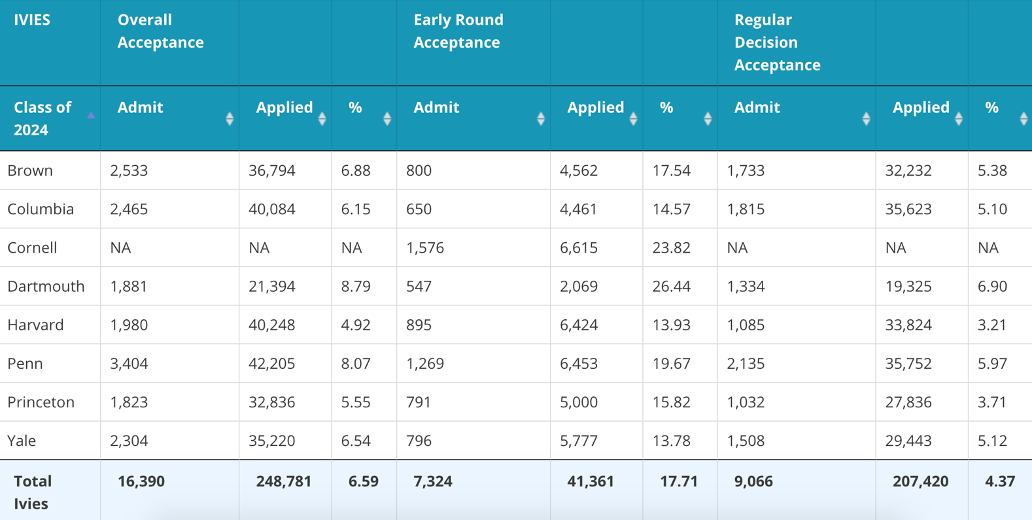Post by: Dr. Michele Hernandez
We’ve had vigorous debates on this blog and with students and parents about the merits of early decision. As a brief primer, both early action and early decision have early November deadlines, but early action is NON binding (you do not have to say “yes”) while early decision is binding (you have to say “yes” and withdraw any other applications). The confusing thing is that Harvard, Yale, and Stanford have a “single choice/restrictive” early action policy (non-binding but you can only apply to state schools or international schools as back up) while the other five Ivies all have normal early decision. Princeton for this cycle is not doing any early round at all which throws a wrench into the scene.
STATISTICS TELL THE STORY
As you can see from the tables below, early decision acceptance rates are 3 to 4 times higher than regular only acceptance rates while early action acceptance rates are higher, but not by as big a margin with the exception of MIT. The one thing that is indisputable is that regular only admittance rates are super low from 2-3% at Stanford (which didn’t give out exact numbers from this cycle so we are guesstimating) and Harvard to a “high” of 6-7%. Looking at just the numbers, there is a clear advantage to applying early action/early decision at every school. But as many perceptive readers of past posts pointed out, the difference is not quite as sharp because legacies and recruited athletes tend to get accepted in the early decision round so while it may look like Dartmouth takes 26% of ALL early applicants, it is going to be less than that for “non-hooked” applicants. As I will illustrate below, even so, it is worth it to apply early decision to increase your odds. Some argue that early decision can lock you into a financial bind as you cannot compare financial aid packages so is “only for the wealthy.” That is not true because the Ivies bend over backwards to give generous aid packages once they commit to a student and in the worst case scenario, you can be released from the early decision agreement if after you appeal your financial aid award, you still cannot afford it.
REASONS EARLY DECISION STILL MAKES SENSE
- Even taking into account legacies and recruited athletes, the acceptance rate is still higher than regular round.
- There are MANY fewer applicants in the early round (look at the table below – sometimes 8-10 times fewer in early!) which means your application, essays, teacher recs and materials are read much more carefully and typically by admissions officers rather than outside readers.
- Not only are there fewer applicants in early, but with legacies and athletes who tend to be in the lower side academically, truly strong applicants who are academic superstars shine brighter in the early decision round than in the regular round. To say it another way, the regular round is much more competitive with many of the nation’s top students waiting until regular round. The early round overall is weaker because of the recruited athletes and legacies and “reach” applicants.
- Applying early decision tells the college that you picked them first – and you love their school and are willing to commit. That means for a student who might be “on the border,” often admissions officers will take that student in early but not in regular. This is demonstrated interest on steroids.
- What about getting deferred? Think of it this way, if you were deferred in the early round, you would have been rejected in the regular round, so nothing lost there. Plus, deferred students have a chance to send an update with new grades, awards, scores, etc… and roughly 5-15% of deferred kids (depending on the school) will be accepted during the regular round. The advantage is that the college knows it is your top choice, signaled by the original ED choice.
- Finally, with COVID still in the picture, many schools (especially small liberal arts schools) have lost a ton of tuition dollars from last year plus have many added expenses to develop a Coronavirus plan (paying for HEPA filters, more ventilation, etc…). That means that students who don’t need financial aid AND who apply ED will have higher admissions odds this year.
- Related to the above, we predict that many liberal arts colleges along with top universities will admit a higher percentage of the class in the ED round to lock in tuition paying students.
MAGIC WANDS
As I’ve argued before, if I could wave my magic wand, I would force all the top colleges to have two rounds of early decision (I and II) but 1- limit the number to perhaps only 30-35% of the total class rather than 50% as U Penn takes now for example) and 2- provide super generous financial aid/grants to students. That way colleges could still reserve 60-70% of the spots for regular round but still give students two rounds to indicate a true first choice. I would eliminate single choice early action so HYPS don’t artificially elevate themselves over the other schools simply based on policy. In a typical year, 20,000 to 25,000 students are deferred or rejected from HYPS, freak out, and then apply to 20-30 schools in regular round. That is why the system is flooded with a ridiculous number of applicants in regular round. Changing the system would reduce that number dramatically. But no school wants to act in a vacuum – they need to join hands and take the plunge all at once to insert some measure of sanity into the process.
IVY LEAGUE — CLASS OF 2024
MIT AND STANFORD — CLASS OF 2024

- Top Tier Admissions Statement on ChatGPT and Generative AI - January 25, 2024
- Calculate Your Academic Index: The Secret Formula - April 20, 2023
- Top Tips If You Were Deferred:2021 - December 6, 2021



